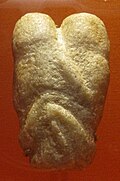Epipalaeolithic
The Epipaleolithic or "peripheral old Stone Age" is a term used for the hunter-gatherer cultures that existed after the end of the last Ice Age, before the Neolithic.
The term is sometimes confused with Mesolithic, and the two are sometimes used as synonyms. Yet, when a distinction is made, 'Epipaleolithic' describes cultures that were not much affected by the ending of the Ice Age.[1] Meanwhile, the term 'Mesolithic' is reserved for Western Europe, where the extinction of the Megafauna had a great influence on the Palaeolithic populations at the end of the Ice Age.
Epipalaeolithic Media
En Gev Epipaleolithic period Basalt Israel Antiquities Authority H: 29 cm; Diam: 25-28 cm; Weight: 11 kg Prehistoric Periods The Israel Museum, Jerusalem Archaeology. Stone Age Stone Mortar & Pestle, Kebaran culture, 22000-18000 BP*Israel Museum, Jerusalem, Israel. Complete indexed photo collection at WorldHistoryPics.com.
The Epipaleolithic corresponds to the first period of progressive warming after the Last Glacial Maximum. Evolution of temperatures in the Post-Glacial period according to Greenland ice cores.
Microliths tools from Ein Qashish South, Jezreel Valley, Israel, Kebaran and Geometric Kebaran, ca. 23,000-16.500 BP
The Ain Sakhri lovers, Ain Sakhri near Bethleem, Israel. Kebaran culture, Late Epipaleolithic Near East
References
- ↑ like the Natufian culture of Western Asia (see article agriculture, origins of. (2008). In Encyclopædia Britannica. Retrieved April 10, 2008, from Encyclopædia Britannica Online).




